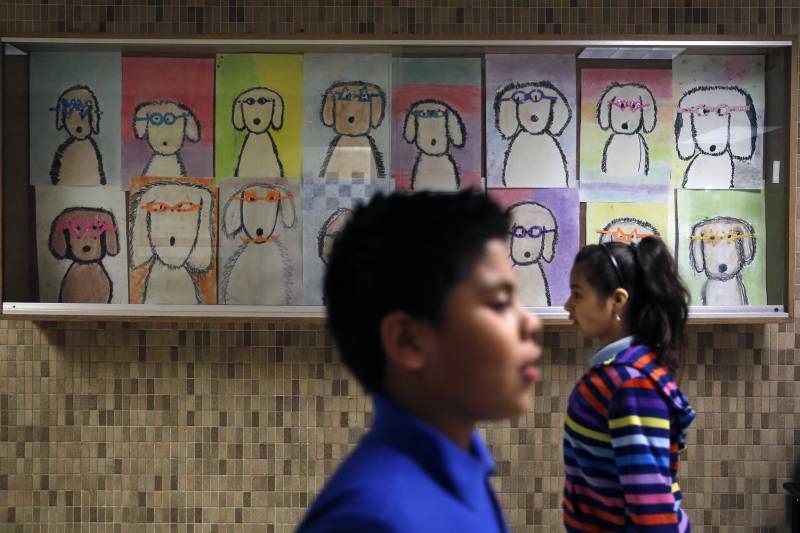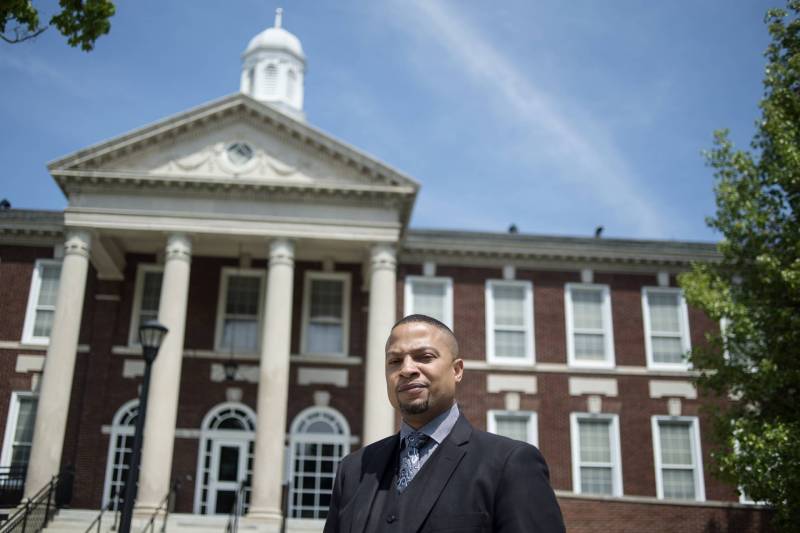When this school year began, Issac Moreno just couldn’t get himself to go. During the pandemic, he’d gotten used to learning from his family’s home in Los Angeles. Then, last fall, he started junior high, five days a week, in person.
“It was a lot,” he says.
The last fully normal school year Issac remembers is third grade. Now, he’s in seventh, with multiple classes each day, a busier schedule and new classmates.
Issac’s mother, Jessica Moreno, says it’s been a struggle to get Issac back into the routine of going to school. Her eyes well up as she describes it: “Three days a week or four days a week, he will say to me, ‘I’m sick. I don’t feel OK. Can you just pick me up? I don’t want to be here.’ ”
She says Issac has already missed 10 days of school this year, which means he’s at risk of becoming chronically absent.
And Issac is not alone. Before the pandemic, about 8 million U.S. students were considered chronically absent, according to the research group Attendance Works. That’s when a student misses 10% or more of the school year. By spring 2022, that number had doubled to around 16 million.
Federal attendance data only comes out annually, so it’s hard to get a full picture of where things stand at this point in the school year, but Hedy Chang, the executive director of Attendance Works, says she hasn’t seen the kind of recovery she’d hoped for.
“I think people have been a little bit under the false impression that when COVID became more endemic, that that would then result in a significant improvement in attendance. And I’m not seeing that.”
In a survey of 21 school districts in rural, suburban and urban areas, NPR found most districts – from New York City to Austin, Texas, to Lawrence, Kan. – still had heightened levels of chronic absenteeism.
Students who are chronically absent are at higher risk of falling behind, scoring lower on standardized tests and even dropping out. And as often happens in education, students who struggle with attendance are also more likely to live in poverty, be children of color or have disabilities.
Chang worries the kids missing out on school are the same ones who need it the most.
“Showing up to school makes sure that you have access to resources,” she says, “whether that’s food and nutrition, whether that’s after school and engaging learning experiences, whether that’s access to health care.”
Why students aren’t showing up to class
In Anne Arundel County Public Schools, outside Baltimore, chronic absenteeism has worsened over each of the last three years.
“Transportation has been our number one issue,” says Ryan Voegtlin, director of student services for the large Maryland district. He says a bus driver shortage has made it hard to cover all the bus routes and guarantee transportation for every student.
“That impacts a lot of our higher poverty areas where some of our parents don’t have as flexible of jobs, where they may not have their own transportation.”
According to Voegtlin, increased mental health concerns and heightened caution around sending kids to school when they’re not feeling well have also taken a toll on attendance.
In rural San Juan County, New Mexico, Superintendent Steve Carlson says attendance numbers have improved this year, but they haven’t returned to pre-pandemic levels. He echoes the challenges Voegtlin described, with one exception: His school district, Central Consolidated, is partially in Navajo Nation, and his schools serve Native American communities that were disproportionately affected by COVID, with higher infection and hospitalization rates compared to other groups. Families in his district are still recovering emotionally, and the schools still have mask mandates. There’s also still fear around large gatherings of people, which are hard to avoid in schools. Moreover, given the history of boarding schools, Carlson says his district’s Native families don’t generally think of school as a safe place.
“It’s really difficult to get those families to say, ‘Yeah, sure, we’d love to send our kids back to school.'”
In Issac Moreno’s district, Los Angeles Unified School District (LAUSD), attendance has improved compared to last school year, but Superintendent Alberto Carvalho says it hasn’t yet returned to pre-pandemic levels.
“Much needs to be fixed alongside the attendance issue, because there are root causes that are keeping kids from school,” he says.
Carvalho describes the same attendance challenges NPR heard from multiple districts around the country: a youth mental health crisis, heightened fear around health concerns, transportation difficulties and poverty and homelessness, which can make it difficult for students to keep a routine around going to school.
Several school leaders also told NPR they worry their students have lost a sense of belonging in the classroom after so much time away. Hedy Chang of Attendance Works shares those concerns:
“[Students have] lost connections to peers, they’ve lost connections to adults, and it has certainly been exacerbated by very challenging staffing issues in schools. But that means we need to be even more intentional about relationship building, connecting to kids.”

What schools can do to improve attendance
Carvalho says, “Money is not an issue … The entire nation is currently flooded with federal [COVID] assistance money.”
And many districts – including LAUSD, Anne Arundel County and Central Consolidated – are using that money to address absenteeism.
Home visits are one proven strategy schools are investing in. The state of Connecticut put close to $10.7 million of its federal relief aid toward a robust home-visit program; six months later, attendance improved by about 15 percentage points among students in the program.
Chang says, while home visits are effective, “how you do them matters a lot.” She says the most successful home-visit programs involve trained school staff or teachers who make repeated visits and maintain ongoing relationships throughout the year.
LAUSD recently started using its home-visit program to target children experiencing housing insecurity. “The most vulnerable kids who are absent the most [in L.A.] happen to be homeless children,” Carvalho told NPR after touring a crisis center where such children sought shelter.
His district has also hired more attendance counselors and “community navigators” to help caregivers tap into district resources, and it’s providing concierge transportation for students with unstable housing.
In New Mexico, Steve Carlson is investing in more mental health resources, including extra counselors. And in Maryland, Voegtlin has hired more bus drivers, though he still doesn’t have enough for every bus route. Voegtlin’s district is also reaching out to families before students become chronically absent, and he and his team are working to educate caregivers about the long-term impacts of kids missing school.
“It’s not a quick process,” he explains, “but it’s a process that [has allowed] people to start understanding that everyone owns attendance, and not just when it gets to the chronic point.”
He says his district tries to avoid the punitive approaches of years past. For example, they only file charges in truancy court as a last resort after exhausting other attempts to connect with families.
Chang says another way to improve attendance is to gather regular, transparent data throughout the school-year, rather than only once, at the end of the year.
“When you look at your data regularly on an individual level, it can allow you to reach out to students before the challenges are so entrenched that you can’t turn them around,” she says.

In Michigan, Grand Rapids Public Schools collects and analyzes data multiple times a month. Mel Atkins, who leads attendance efforts there, has found sharing that data widely can make a difference.
“I know you need the data to know where we’re going and how big the problem actually is,” he explains. “So we share the data with community partners, parents.”
Before the pandemic, he says his district used 8-foot leaderboards to display monthly attendance data. “It wasn’t always good, but what it did was spark a conversation.”
That data-driven program helped cut chronic absenteeism by more than half in his district. The pandemic hampered much of that progress, but Atkins says he and his team are focused on restarting those efforts, and getting back to a playbook they already know works.
Giving students a sense of belonging at school
Nearly every educator NPR spoke to for this story said they want to provide a school environment that gives students a sense of belonging – one that hopefully gets them back into the classroom.
“We want to provide environments where students want to be, so when they walk in the door, they feel safe and they say, ‘I’m welcome here and I want to learn,’ ” says Carlson of New Mexico.
One way to create environments where students want to be is to give them some say. At Brooklyn Center Middle and High School, just outside Minneapolis, students asked for more classes outside the traditional curriculum, and the school responded by offering two class periods a week in which students get to pick from classes like “Create Your Own Video Game,” “Art in the Garden” and “Dungeons and Dragons.”
Between December 2021 and December 2022, the school cut absenteeism by more than half. Principal Josh Fraser says his team hasn’t yet collected enough data to prove the new classes directly led to better attendance, but he says the vast majority of students have found a subject they identify with, and that has been key.
“The value of students seeing the power and voice they have, and it actually reflecting in decisions that hugely impact their day-to-day…I think it’s something that creates belonging,” he says.
A sense of belonging has started to make a difference for Issac Moreno, in L.A. His middle school recently launched a new sports program, which he was eager to join.
“That’s something that kind of made school fun again,” says Issac, in his L.A. Lakers jersey. He’s been playing basketball and says the “fun” parts of the school day have motivated him to show up more.
“I’m a very social person and I’m very glad that [at school] you can talk to people and just be a lot more active,” he says.
His mom says she’s seen a difference in Issac since the sports program opened up. “He’s playing basketball again, he now has friends…and it is giving him his life back.”
A life that’s starting to look much closer to normal.
Edited by: Nicole Cohen
Copyright 2023 NPR. To see more, visit https://www.npr.org.9(MDAxOTAwOTE4MDEyMTkxMDAzNjczZDljZA004))